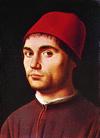- Antonello da Messina
-
/ahn'taw nel"law dah mes see"nah/, (Antonello di Giovanni degli Antonj)1430?-79, Sicilian painter.
* * *
died с Feb. 19, 1479, MessinaItalian painter.Trained in Naples, then a cosmopolitan art centre, he studied the Flemish artists, notably Jan van Eyck. Based on these experiences, when he returned to Venice he introduced oil painting and Flemish pictorial techniques into mid-15th-century Venetian art. His major works were altarpieces and portraits. In Venice he executed the San Cassiano altarpiece, of which three fragments remain. His portrait busts in three-quarter view, combining Flemish detail with Italian grandeur, became fashionable. Antonello's practice of building form with colour rather than line and shade greatly influenced the subsequent development of Venetian painting. See also Venetian school. "Portrait of a Man," panel painting by Antonello da Messina, c. 1472; in the National ...Courtesy of the trustees of the National Gallery, London
"Portrait of a Man," panel painting by Antonello da Messina, c. 1472; in the National ...Courtesy of the trustees of the National Gallery, London* * *
▪ Italian painterborn c. 1430, Messina, Sicilydied c. Feb. 19, 1479, Messinapainter who probably introduced oil painting and Flemish pictorial techniques into mid-15th-century Venetian (Venetian school) art. His practice of building form with colour rather than line and shade greatly influenced the subsequent development of Venetian painting.Little is known of Antonello's early life, but it is clear that he was trained in Naples, then a cosmopolitan art centre, where he studied the work of Provençal and Flemish artists, possibly even that of Jan van Eyck. His earliest known works, a “Crucifixion” (c. 1455; Museum of Art, Sibiu, Rom.) and “St. Jerome in His Study” (c. 1460; National Gallery, London), already show Antonello's characteristic combination of Flemish technique and realism with typically Italian modelling of forms and clarity of spatial arrangement.In 1457 Antonello returned to Messina, where he worked until 1474. The chief works of this period, the polyptych of 1473 and the “Annunciation” of 1474 (both in the Museo Nazionale, Messina), are relatively conservative altarpieces commissioned by the church, but the “Salvator Mundi” (1465; National Gallery, London), intended for private devotions, is bold and simple, showing a thorough understanding of the human form and the depiction of personality. It was but a short step from the “Salvator Mundi” to such incisive characterizations of human psychology as seen in “Portrait of a Man” (c. 1472; National Gallery, London), a work that presaged the uncanny vitality and meticulous realism of such panels as “Portrait of a Condottiere” (1475; Louvre, Paris), which established his reputation in northern Italy. During this period Antonello might have traveled to Rome and come into contact with the works of Fra Angelico and Piero della Francesca.From 1475 to 1476 Antonello was in Venice and possibly Milan. Within a short time of his arrival in Venice, his work attracted so much favourable attention that he was supported by the Venetian state, and local painters enthusiastically adopted his oil technique and compositional style. In “St. Sebastian” (c. 1476; Gemäldegalerie, Dresden, Ger.), his most mature work, Antonello achieved a synthesis of clearly defined space, monumental, sculpture-like form, and luminous colour, which was one of the most decisive influences on the evolution of Venetian painting down to Giorgione's day. In 1476 he was again in Messina, where he completed his final masterpiece, “The Virgin Annunciate” (c. 1476; Galleria Nazionale, Palermo).* * *
Universalium. 2010.
